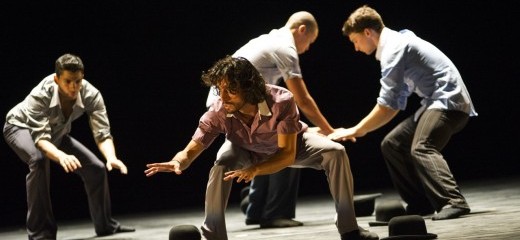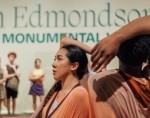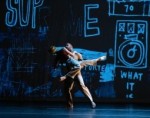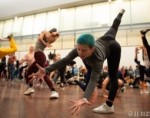
It's About the Conversation
by Patricia Graham
Patricia Graham chats with Ballet Hispanico Artistic Director Eduardo Vilaro. Ballet Hispanico is dedicated to exploring, preserving and celebrating Latino cultures through dance. www.ballethispanico.org/about/history-mission
PG: I’m very curious about the choreography you’re presenting at Montgomery County College, especially in light of BH’s mission as a conduit of Latino culture. Could you talk about the program?
EV: We’re opening the program with Asuka, which is a work that I did two years ago and it celebrates the life of Celia Cruz. A lot of her fabulous songs from her early days are a part of it. There are themes of leaving home, of relationships - including a Celia figure and her relationship with her husband. It’s a fun, energetic piece - colorful and very poignant. Celia Cruz kept me connected to my home land of Cuba, while assimilating here in the States. I did it for her passing and because she was such a powerful figure for me.
Then we move on to Sombrerísimo. It comes from the root word sombrero and it’s a play on what “ísimo” means. Like, I love you is great but if I love you muchísimo, it’s the greatest. So this is Sombrerísimo, the most attitude. It’s a playful piece for six men about how something as simple as a prop can identify you and also be the source of a community. It’s the tour de force for the men in the company.
Then we go into a very contemporary duet called Sortijas. Sortijas is an old Spanish word for band or wedding band. It is a look at a cyclical relationship from a very contemporary and edgy perspective - a short piece with interesting music by Lasa, a Mexican artist. The last work is by Annabella Lopez Ochoa called Mad’moiselle. It explores the many stereotypes of women, in Latin America, starting with the name María. There are all the different aspects of María – María the flirt, María the “ya know” - a little worse than a flirt - María the strong person, María the manipulator. The vocabulary is quirky and somewhat provocative at the same time, with simple costuming, just a black and red theme. It’s a tongue and cheek look at that culture.
The program really gives you a very diverse perspective in the way different Latinos and Latinas look at their culture. That’s what I love to do – move us from stereotype and open the dialogue to “Who do we think we are now?” We know what the past was – we see those icons all the time. I love this program.
PG: Does this dialogue include direct talk with your audience before or after the performance?
EV: We’ll have a question and answer after the show. I love to dialogue with the audience. It’s great for me, it’s great for them, and it’s great for the artists.
PG: Looking at contemporary ballet, the question has come up whether the dance was really opening the form. It seems that when we label dance as contemporary ballet there is an expectation that some boundaries will be pushed. It’s nice to hear some of the challenges you’re taking on with your choreography.
EV: I think it’s contemporary and it’s still accessible. There are some that are a little more challenging but I’m willing to take that because it pushes us to think. That’s the thing about art, any kind of art. There’s a difference between making a statement and moving the art form. I think they’re one and the same; people just have different ideas about what that means.
PG: Right. And to that end, do you have any particular choreographers that you want to keep going back to - who are pushing the company and the dancers in particular ways?
EM: Yes, yes, all of these choreographers. Annabella Oachoa we’ve had a long relationship with, Sortijas by Cayetano Soto is one of those. And we’re always looking for more and nurturing more. Instituto Coreográfico is a choreographic institute that we have every year and we invite emerging artists to work a couple of weeks with the dance company on an idea, so they get room, they get to work with professional dancers and we see if something comes together. But it’s important for us as a 43-year-old organization to take that leap.
PG: Can you speak a little bit more about your vision for the company into the future?
EV: How much time do you have? When this company was developed back in the ‘70’s, it was developed to give voice to the Latino artist and the Latino in dance. I think at this point in our development, we’re already at the table and we now need to take a leadership role in helping people understand what cross-cultural dialogue is. We’ve been nurturing and developing our artists, and because of that, we’ve been turning out leaders. Before, we were waiting for a seat on the bus --now we want to drive the bus!
PG: How does this work, given the multiple activities of the Company?
EV:There is a nurturing aspect in each and everything we do, for example the School of Dance that we have for kids. How do we go deeper now, how do we really serve the underserved to the max? We’re looking at how our scholarships can go deeper into the community, find those kids, rescue those kids by giving them the opportunities to look at the Arts as an option. That happened for me as a kid from the Bronx.
Then too, we’re always looking for choreographers who’ve been doing exciting work. Next year at the Joyce we’ll be celebrating Mexican choreographers of the day. At the same time, we’ll have a Carmen. That means we go back and forth - thinking of ourselves as a repertory company who preserves works and asking as well: what does it mean to be the national Latino dance company? We’re always looking at how we serve all our constituents.
PG:I was wondering if that ever became difficult because the Latino Diaspora is vast across many countries. Does that add another level of complexity with what you do?
EV: Exactly, and I think it’s a good level, it’s a challenging level, that level of complexity. I don’t think the challenge so much is the service, it’s the conversation we have. We have to go into each of these constituent communities and bring them to the table, have them be part of the discussion. So when we go into a school we ask, “What do you really want? Let’s go to a middle ground.” We’re not just dictating what these students should learn, how they should learn, but their voices are found within the work that we do. And they will tell us. I don’t want to go into a Mexican community and just teach them tango. I want to find out what are some of the dances you do? How can we bring that? How can we deconstruct? You be the artist!
PG: What is the dancers’ daily routine as far as training? Are they oriented around ballet and modern technique? Do they study Spanish dance forms on a regular basis or does it all depend on the piece they’re working on?
EV: All of the above. They warm-up every day with a very professional-level ballet class because that is the balancer. At times they ask for contemporary classes and I bring in contemporary artists for classes. Last year Annabelle Ochoa did a piece that had a lot of flamenco in it. We brought in some of the fabulous flamenco teachers from our school to work with the dancers. This gave them a better sense of the traditional stances and carriage, and helped them understand how this choreographer would want to blend the forms. We do a little bit of everything but their daily regimen is a ballet class. It just centers them, so they can then release the technique.
PG: What do you look for in a dancer?
EV: I, like most choreographers, look for artists that are willing to take a risk, both physically and personally. For this company, I love dancers that love to teach and share, because we do so much work in the community and interaction. This is a great group of artists who love to share their work and that translates into teaching and workshopping with people. And I love big personalities, when I see someone find the joy, because their dancing, it’s just magical! In this company, you can see it all the time.
Ballet Hispanico, Montgomery County Community College, March 8, $30, 215-641-6518, www.mc3/images/pdf/lively-arts/brochure.pdf
By Patricia Graham
March 9, 2014








